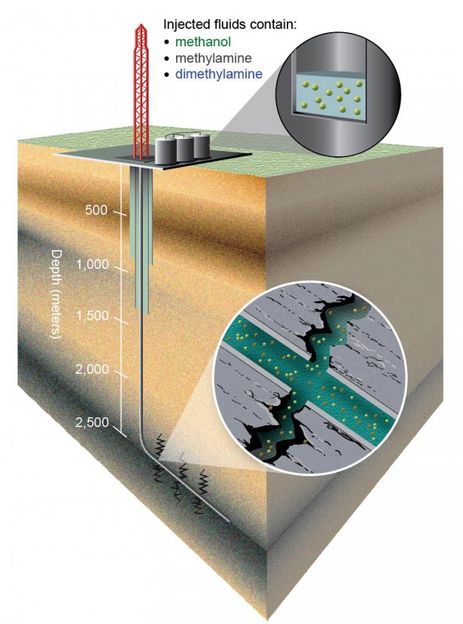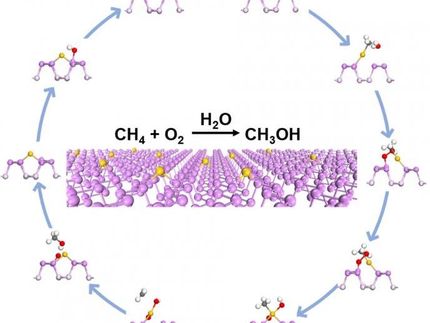Some gas produced by hydraulic fracturing comes from surprise source
Some of the natural gas harvested by hydraulic fracturing operations may be of biological origin--made by microorganisms inadvertently injected into shale by oil and gas companies during the hydraulic fracturing process, a new study has found.

This is a cross-section of the hydraulic fracturing process.
Michael Wilkins, courtesy of The Ohio State University
The study suggests that microorganisms including bacteria and archaea might one day be used to enhance methane production--perhaps by sustaining the energy a site can produce after fracturing ends.
The discovery is a result of the first detailed genomic analysis of bacteria and archaea living in deep fractured shales, and was made possible through a collaboration among universities and industry. The project is also yielding new techniques for tracing the movement of bacteria and methane within wells.
"A lot is happening underground during the hydraulic fracturing process that we're just beginning to learn about," said principal investigator Paula Mouser, assistant professor of civil, environmental and geodetic engineering at The Ohio State University.
"The interactions of microorganisms and chemicals introduced into the wells create a fascinating new ecosystem. Some of what we learn could make the wells more productive."
Oil and gas companies inject fluid - mostly water drawn from surface reservoirs - underground to break up shale and release the oil and gas - mostly methane - that is trapped inside. Though they've long known about the microbes living inside fracturing wells--and even inject biocides to keep them from clogging the equipment--nobody has known for sure where the bacteria came from until now.
"Our results indicate that most of the organisms are coming from the input fluid," said Kelly Wrighton, assistant professor of microbiology and biophysics at Ohio State. "So this means that we're creating a whole new ecosystem a mile below the surface. Not only are we fracturing the rock, we're giving these organisms a new place to live and food to eat. And in fact, the biocides that we add to inhibit their growth may actually be fueling the production of methane."
That is, the biocides kill some types of bacteria, thus enabling other bacteria and archaea to prosper - species that somehow find a way to survive in water that is typically four times saltier than the ocean, and under pressures that are typically hundreds of times higher than on the surface of the earth. Deprived of light for photosynthesis, these hardy microorganisms adapt in part by eating chemicals found in the fracturing fluid and producing methane.
Next, the researchers want to pinpoint exactly how the bacteria enter the fracturing fluid. It's likely that they normally live in the surface water that makes up the bulk of the fluid. But there's at least one other possibility, Wrighton explained.
Oil and gas companies start the fracturing process by putting fresh water into giant blenders, where chemicals are added. The blenders are routinely swapped between sites, and sometimes companies re-use some of the well's production fluid. So it's possible that the bacteria live inside the equipment and propagate from well to well. In the next phase of the study, the team will sample site equipment to find out.
The clues emerged when the researchers began using genomic tools to construct a kind of metabolic blueprint for life living inside wells, Wrighton explained.
"We look at the fluid that comes out of the well," she said. "We take all the genes and enzymes in that fluid and create a picture of what the whole microbial community is doing. We can see whether they survive, what they eat and how they interact with each other."
The Ohio State researchers are working with partners at West Virginia University to test the fluids taken from a well operated by Northeast Natural Energy in West Virginia. For more than a year, they've regularly measured the genes, enzymes and chemical isotopes in used fracturing fluid drawn from the well.
Within around 80 days after injection, the researchers found, the organisms inside the well settle into a kind of food chain that Wrighton described this way: Some bacteria eat the fracturing fluid and produce new chemicals, which other bacteria eat. Those bacteria then produce other chemicals, and so on. The last metabolic step ends with certain species of archaea producing methane.
Tests also showed that initially small bacterial populations sometimes bloom into prominence underground. In one case, a particular species that made up only 4 percent of the microbial life going into the well emerged in the used fracturing fluid at levels of 60 percent.
"In terms of the resilience of life, it's new insight for me into the capabilities of microorganisms."
The researchers are working to describe the nature of pathways along which fluids migrate in shale, develop tracers to track fluid migration and biological processes, and identify habitable zones where life might thrive in the deep, hot terrestrial subsurface.
For example, Michael Wilkins, assistant professor of earth sciences and microbiology at Ohio State, leads a part of the project that grows bacteria under high pressure and high temperature conditions.
"Our aim is to understand how the microorganisms operate under such conditions, given that it's likely they've been injected from surface sources, and are accustomed to living at much lower temperatures and normal atmospheric pressure. We're also hoping to see how geochemical signatures of microbial activity, such as methane isotopes, change in these environments," Wilkins said.
Other aspects of the project involve studying how liquid, gas and rock interact underground. In Ohio State's Subsurface Materials Characterization and Analysis Laboratory, Director David Cole models the geochemical reactions taking place inside shale wells. The professor of earth sciences and Ohio Research Scholar is uncovering reaction rates for the migration of chemicals inside shale.
Using tools such as advanced electron microscopy, micro-X-ray computed tomography and neutron scattering, Cole's group studies the pores that form inside shale. The pores range in size from the diameter of a human hair to many times smaller, and early results suggest that connections between these pores may enable microorganisms to access food and room to grow.
Yet another part of the project involves developing new ways to track the methane produced by the bacteria, as well as the methane released from shale fracturing. Thomas Darrah, assistant professor of earth sciences, is developing computer models that trace the pathways fluids follow within the shale and within fracturing equipment.
Though oil and gas companies may not be able to take full advantage of this newly discovered methane source for some time, Wrighton pointed out that there are already examples of bio-assisted methane production in industry, particularly in coal bed methane operations.
"Hydraulic fracturing is a young industry," she said. "It may take decades, but it's possible that biogenesis will play a role in its future.





























































